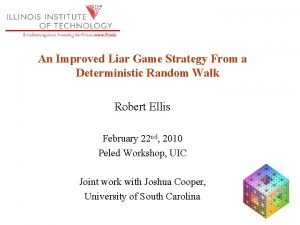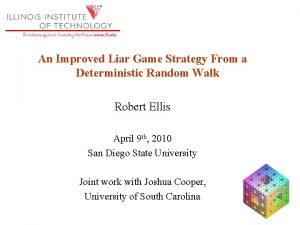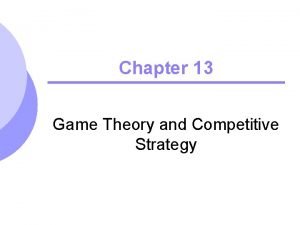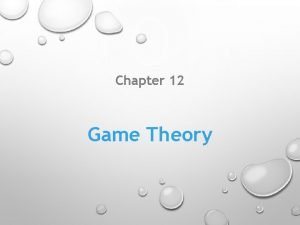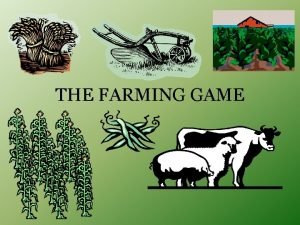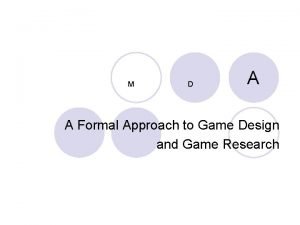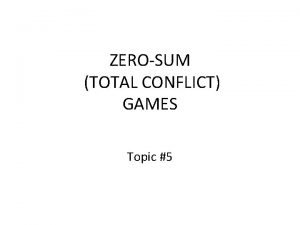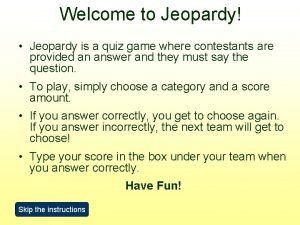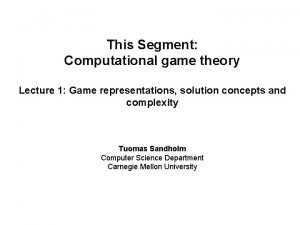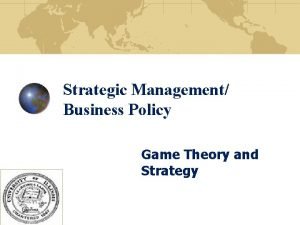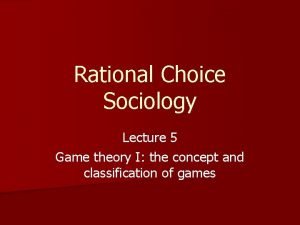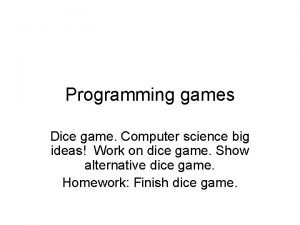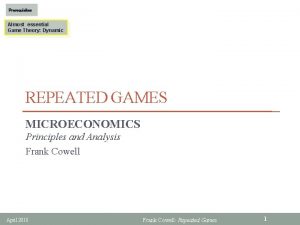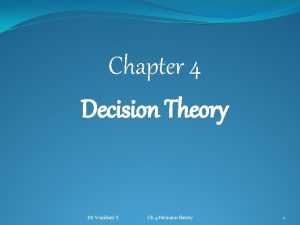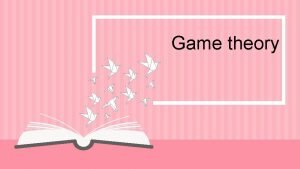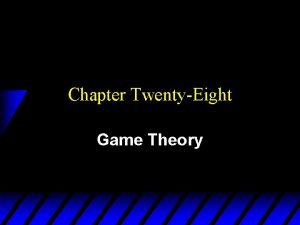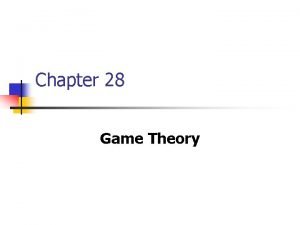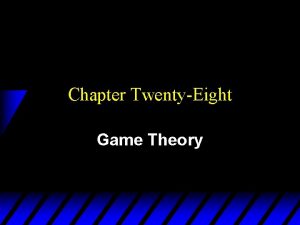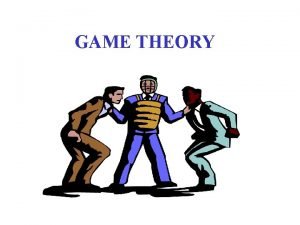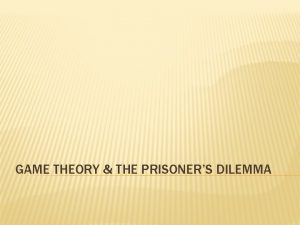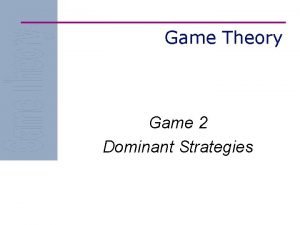Chapter 6 Game Theory Dr Wasihun Tiku Ch















- Slides: 15

Chapter 6 Game Theory Dr. Wasihun Tiku Ch 6 1

6. 1 Introduction � Life is full of conflict and competition. Numerical examples involving in conflict include games, military, political, advertising and marketing by competing business firms and so forth. A basic feature in many of these situations is that the final outcome depends primarily upon the combination of strategies � Game theory is a mathematical theory that deals with the general features of competitive situations like these in a formal, abstract way. It places particular emphasis on the decision-making processes. Dr. Wasihun Tiku Ch 6 2

Con’t � Research on game theory continues to deal with complicated types of competitive situations. However, we shall be dealing only with the simplest case, called two-person, zero sum games. � As the name implies, these games involve only two players . They are called zero-sum games because one player wins whatever the other one loses, so that the sum of their net winnings is zero. Dr. Wasihun Tiku Ch 6 3

Con’t � In v v v general, a two-person game is characterized by The strategies of player 1. The strategies of player 2. The pay-off table. Dr. Wasihun Tiku Ch 6 4

Thus the game is represented by the payoff matrix to player A as B 1 B 2 ……… Bn A 1 a 12 ……… a 1 n A 2 a 21 a 22 …. . . . A 2 n Am am 1 am 2 ………. amn . . Dr. Wasihun Tiku Ch 6 5

Con’t � Here A 1, A 2, …. . , Am are the strategies of player A B 1, B 2, …. . . , Bn are the strategies of player B aij is the payoff to player A (by B) when the player A plays strategy Ai and B plays Bj (aij is –ve means B got |aij| from A) � A primary objective of game theory is the development of rational criteria for selecting a strategy. Two key assumptions are made: Ø Both players are rational Both players choose their strategies solely to promote their own welfare (no compassion for the opponent) Ø Dr. Wasihun Tiku Ch 6 6

Rules, Strategies, Payoffs, and Equilibrium Situations are treated as games. ◦ The rules of the game state who can do what, and when they can do it ◦ A player's strategy is a plan for actions in each possible situation in the game ◦ A player's payoff is the amount that the player wins or loses in a particular situation in a game ◦ A players has a dominant strategy if his best strategy doesn’t depend on what other players do Dr. Wasihun Tiku Ch 6 7

Optimal solution of two-person zero-sum games � Determine the saddle-point solution, the associated pure strategies, and the value of the game for the following game. The payoffs are for player A. Dr. Wasihun Tiku Ch 6 8

Example 1 B 2 B 3 B 4 A 1 8 6 2 8 2 A 2 8 9 4 5 4 A 3 7 5 3 Col 8 Max 9 4 8 max min max Dr. Wasihun Tiku Ch 6 Row min 9

Con’t The solution of the game is based on the principle of securing the best of the worst for each player. If the player A plays strategy 1, then whatever strategy B plays, A will get at least 2. Similarly, if A plays strategy 2, then whatever B plays, will get at least 4. and if A plays strategy 3, then he will get at least 3 whatever B plays. Thus to maximize his minimum returns, he should play strategy 2. Dr. Wasihun Tiku Ch 6 10

Con’t Now if B plays strategy 1, then whatever A plays, he will lose a maximum of 8. Similarly for strategies 2, 3, 4. (These are the maximum of the respective columns). Thus to minimize this maximum loss, B should play strategy 3 and 4 = max (row minima) = min (column maxima) is called the value of the game. 4 is called the saddle-point. Dr. Wasihun Tiku Ch 6 11

Example 2 Specify the range for the value of the game in the following case assuming that the payoff is for player A. B 1 B 2 B 3 A 1 3 6 1 1 A 2 5 2 3 2 A 3 4 2 -5 Col max 5 6 3 Dr. Wasihun Tiku Row min -5 Ch 6 12

Con’t � Thus . � We max( row min) <= min (column max) say that the game has no saddle point. Thus the value of the game lies between 2 and 3. � Here both players must use random mixes of their respective strategies so that A will maximize his minimum expected return and B will minimize his maximum expected loss Dr. Wasihun Tiku Ch 6 13

Dominance and Dominance Principle � Definition: A strategy S dominates a strategy T if every outcome in S is at least as good as the corresponding outcome in T, and at least one outcome in S is strictly better than the corresponding outcome in T. � Dominance Principle: A rational player would never play a dominated strategy. Dr. Wasihun Tiku Ch 6 14

End Dr. Wasihun Tiku Ch 6 15
 Pirate game grid
Pirate game grid Game lab game theory
Game lab game theory Liar game game theory
Liar game game theory Liar game game theory
Liar game game theory Game theory and graph theory
Game theory and graph theory Chapter 13 game theory and competitive strategy
Chapter 13 game theory and competitive strategy Tadelis game theory solutions chapter 12
Tadelis game theory solutions chapter 12 Farming game rules
Farming game rules A formal approach to game design and game research
A formal approach to game design and game research Maximin and minimax principle
Maximin and minimax principle Ghost whisperer quiz
Ghost whisperer quiz Information sets in game theory
Information sets in game theory Dominant vs dominated strategy
Dominant vs dominated strategy Game theory sociology
Game theory sociology Www.dice-programming-etc.com
Www.dice-programming-etc.com Folk theorem
Folk theorem


